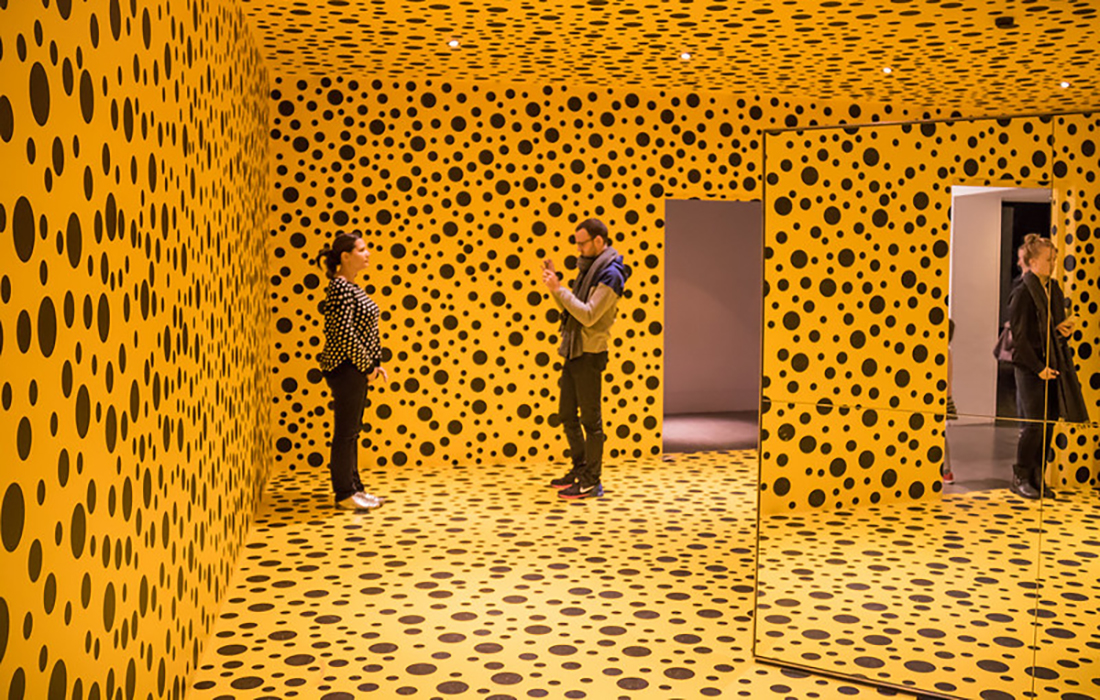
Artwork by Yayoi Kusama
Photo: Susanne Nilsson (CC BY-SA 2.0)
Can artists ever gain control of their work?
Even if their art is immaterial and temporary, artists aren’t always able to decommodify it as they see fit. Emily Wigoder considers the evidence.
Is there a way to decommodify art? This was the question that artists set out to answer in the 1960s with the increasing prevalence of installation art. By creating art that was reliant on its relationship with a particular space, and by making that space one that is open to the public, artists attempted to ensure that their work could not be sold, and therefore contribute towards the increasing wealth of the art market.
It’s a movement to which many artists have contributed, from Yves Klein’s ‘The Void’, where he famously exhibited an empty room, to Kara Walkers’ more recent ‘A Subtlety’, which was built to decay over the course of its installation. As installation art became more popular, however, it too began to be commodified. From museums purchasing installations such as Tracey Emin’s ‘My Bed’, which is not currently on public display, to charging significant entry fees to viewers in order to capitalise on the exhibition, it seems that installation art too has been unable to rebel against the commodification of art in the way that it originally set out to do.
The unpurchasable
So, is this an inevitable part of creating art in our current art world? Let us take a look at some of the art that has emerged since the 1960s and also attempted to decommodify art. Performance art is one art form that many would believe is un-purchasable. How can we purchase the art if it is a person performing? Surely, by nature, the art itself is immaterial and temporary? However, those in the art world desired to be able to collect such art. At first, this was done through photographs of the event, or memorabilia. For example, the Tate owns a piece of Yoko Ono’s dress from her performance ‘Cut Piece’, in which she invited audience participants to cut off pieces of her clothes. Then in New York, MoMA became the first museum to purchase a performance artwork when they acquired Tino Sehgal’s ‘The Kiss’ in 2008 for $70,000. Although exceptionally rare, this showed that performance art too could be bought, if the creator was willing.
We should note, however, that there are many performance artists who will not sell their work. Brian Catling is one such artist, whose work defies commodification. As he said in his 2018 interview with the Guardian: “I made installations that only existed for the run of the show, and then they’d go in a skip. People couldn’t believe I wasn’t selling them… Art has not provided me with a living, because I haven’t let it.”
There are also a wide range of conceptual artists working to prevent their art from being commodified to an unnecessary extent. From Jeremy Deller, who keeps the prices of his artworks low enough to be reasonably affordable for his audience, to Maya Lin, who moulds sculptures in the earth in public spaces, these artists are producing work that does not conform to the art market model. In doing so, they are continuing the rebellion that was begun by their predecessors in the 60s.
No escape?
Unfortunately, regardless of the efforts undertaken by individual artists to push back against the commodification of artworks, this task requires the active support of the artworld audience. Now more than ever, with the rise of apps such as Instagram, the viewer is a crucial part of the conversation about an artwork. Yayoi Kusama began creating her ‘Infinity Rooms’ in the 1960s, immersing her viewer in a space that confronts them with infinities, attempting to address the friction between people and nature. However, the rooms are also highly ‘instagrammable’, and in the last few years, her works have been the feature of hundreds of thousands of selfies posted on Instagram, spreading an entirely less self-reflective message about the artwork. These selfies are reflective of a desire to capture the room, to in some way own a piece of it. This attitude is what has drawn such large crowds, and turned the original message into one that is much more commodified.
Market constraints
The third voice that is needed to change the commodification of art is that of the art markets themselves. When Kusama’s ‘Narcissus Garden’ was first installed, Kusama decided to sell each sphere that made up the work for $2. She was stopped from doing this by the organisers of the Venice Biennial. This is our biggest struggle – to convince the organisers of art markets around the world to allow artists to commodify or decommodify their own work as they see fit.
So we can see that the work begun by artists 60 years ago is far from over. In fact, now, with the importance of the attitude of the viewer, it may be more difficult to carry out than ever. If we are to work towards the decommodification of art, we the audience must become participants. We must work with these artists, and the art world at large, to change the way that these artworks are treated.
Emily Wigoder is a freelance writer
Join the Discussion
You must be logged in to post a comment.